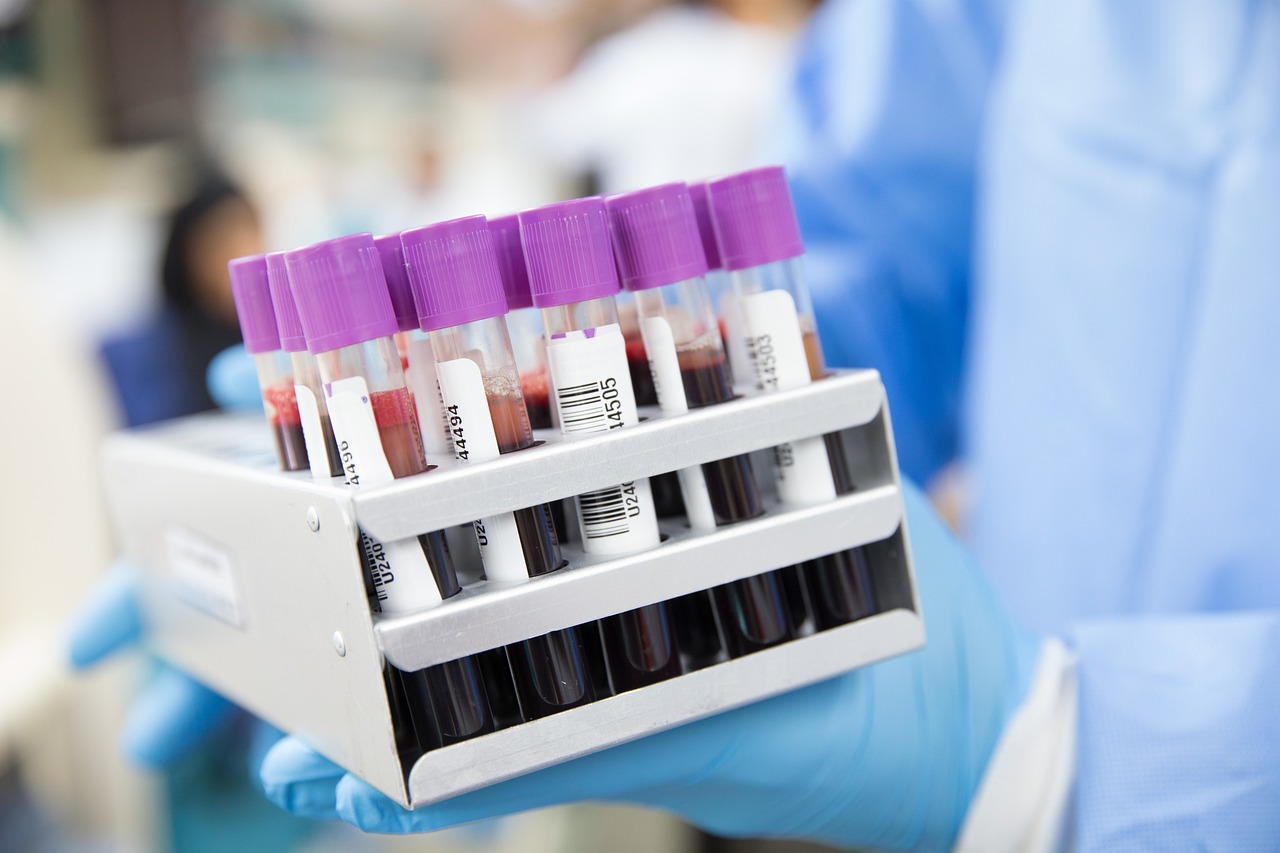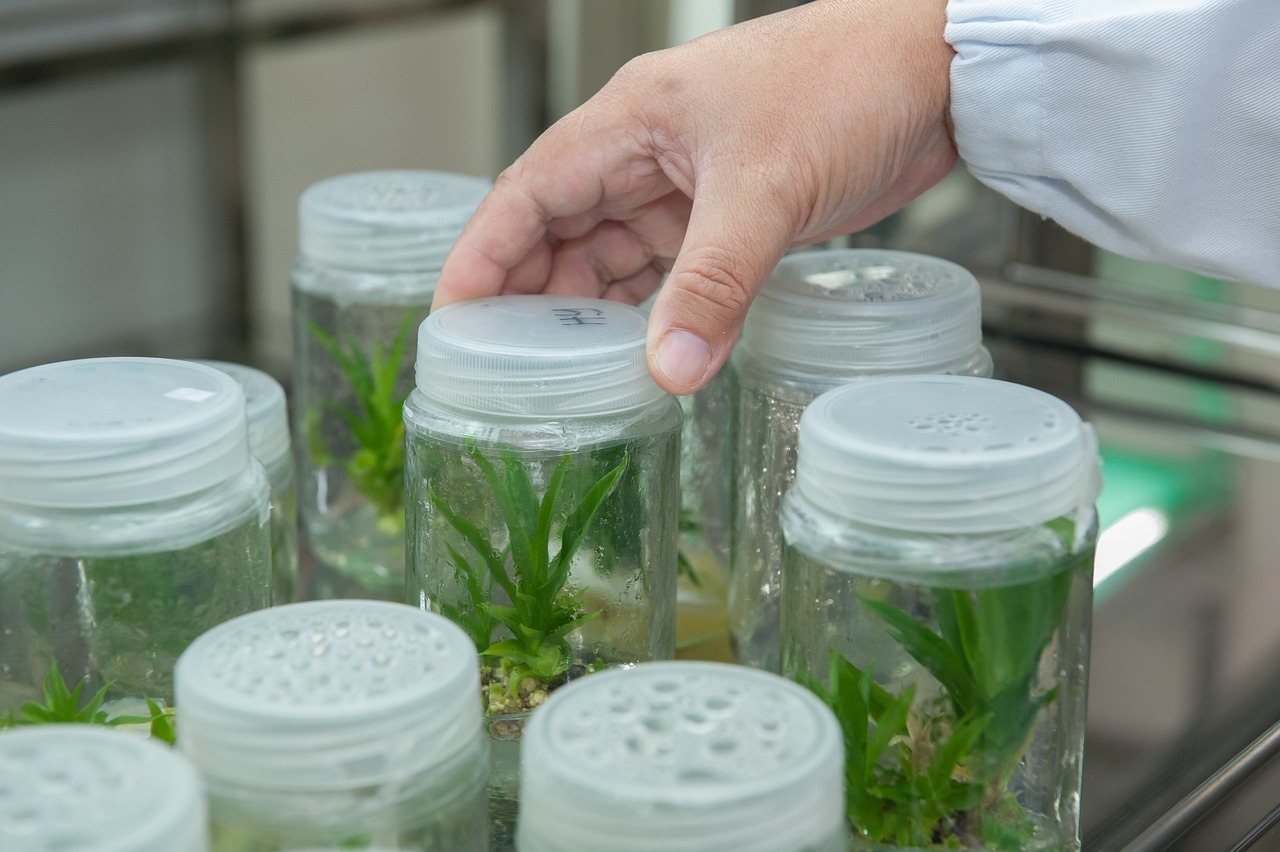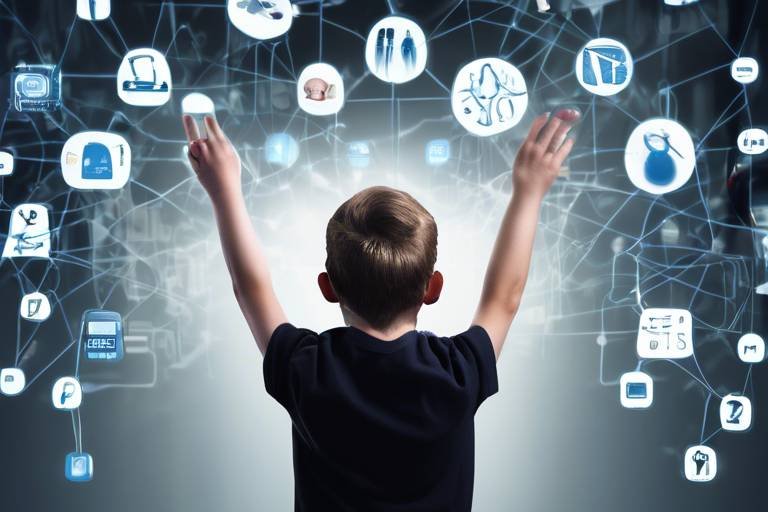How Technology is Changing the Way We Study Biology
In today's fast-paced world, technology is not just a tool; it's a catalyst for change, especially in the realm of education. When it comes to studying biology, the impact of technology is nothing short of revolutionary. Imagine being able to explore the intricate details of cellular structures or genetic sequences from the comfort of your home. With the advent of digital resources, interactive platforms, and advanced analytical tools, students and educators alike are experiencing a transformation in how they learn and engage with biological sciences.
Gone are the days when students had to rely solely on textbooks filled with static information. Now, with just a few clicks, they can access online databases, e-books, and multimedia resources that provide a wealth of information at their fingertips. This immediate access not only enhances understanding but also encourages deeper exploration into topics that pique their interest. For instance, a student curious about CRISPR technology can dive into a plethora of research articles, videos, and interactive content, fostering a more comprehensive grasp of the subject matter.
Furthermore, the rise of interactive learning platforms has made biology not just a subject to study but an experience to engage with. Virtual labs and simulations allow students to conduct experiments and visualize biological processes in real-time, making complex concepts more tangible. Picture yourself observing a cell division process through a simulation, where you can manipulate variables and see the outcomes instantly. This hands-on approach not only makes learning enjoyable but also solidifies understanding by allowing students to apply their knowledge practically.
As we delve deeper into the world of biology education, we also see the emergence of gamification. By incorporating game elements into learning, educators can motivate students to tackle challenging biological concepts through engaging challenges and rewards. This approach not only enhances retention but also fosters a sense of achievement as students progress through various levels of understanding. It’s like turning the study of biology into a thrilling adventure, where each quiz completed and each concept mastered brings them one step closer to becoming experts in the field.
Moreover, the integration of data analysis tools has empowered students and researchers to interpret biological data effectively. In a world where data drives decisions, understanding how to analyze and draw conclusions from complex datasets is crucial. With advanced software, students can engage in bioinformatics and computational biology, exploring genetic sequences and uncovering insights that were once hidden beneath layers of data. This not only sharpens their analytical skills but also prepares them for real-world challenges in biological research.
Lastly, as we look to the future, it's clear that the trajectory of biology education is intertwined with technological advancements. Emerging technologies such as augmented reality and advanced robotics promise to take learning experiences to new heights, offering innovative ways to visualize and interact with biological systems. The integration of interdisciplinary approaches will also ensure that students are well-equipped to tackle the multifaceted challenges of modern biology.
- How has technology improved access to biology education?
Technology has democratized access to information, allowing students from various backgrounds to explore biology through online resources, virtual labs, and interactive platforms. - What role do virtual labs play in biology education?
Virtual labs provide students with a safe and cost-effective environment to conduct experiments and engage with biological concepts without the limitations of physical lab resources. - How does gamification enhance learning in biology?
Gamification motivates students by turning learning into a game-like experience, making complex topics more engaging and enjoyable through challenges and rewards. - What are the benefits of using data analysis tools in biology?
Data analysis tools help students interpret biological data, fostering critical thinking and enabling them to draw accurate conclusions from their research. - What future trends can we expect in biology education?
Emerging technologies like augmented reality and interdisciplinary approaches are set to further enhance the learning experience, preparing students for the complexities of real-world biological challenges.

The Role of Digital Resources
In the ever-evolving landscape of education, digital resources have emerged as a game changer, particularly in the field of biology. Imagine having the entire library of biological knowledge at your fingertips, accessible from the comfort of your home or on the go. This is precisely what digital resources provide—immediate access to a wealth of information that traditional textbooks simply can't match. With online databases, e-books, and scholarly articles available at the click of a button, students can dive deep into topics, conduct research, and enhance their understanding of complex biological concepts.
One of the most significant advantages of digital resources is their ability to facilitate deeper understanding. For instance, students can explore interactive multimedia content, such as videos and animations, that illustrate intricate processes like cellular respiration or genetic mutations. This multi-sensory approach not only makes learning more engaging but also helps in retaining information more effectively. Moreover, the ability to easily search for specific topics allows students to tailor their learning experience according to their needs and interests.
Furthermore, digital resources encourage collaboration and sharing among students and educators. Online platforms enable students to work together on projects, share findings, and discuss ideas in real-time, regardless of their physical locations. This collaborative spirit fosters a sense of community and enhances the learning experience. For example, platforms like Google Scholar and ResearchGate allow users to connect with peers and experts in the field, opening doors to new opportunities and insights.
However, with great power comes great responsibility. While digital resources offer countless benefits, students must also develop critical skills to navigate this vast ocean of information. They need to discern credible sources from unreliable ones, ensuring that the information they gather is accurate and trustworthy. This skill is crucial, especially in biology, where misinformation can lead to misunderstandings about health, ecosystems, and more.
In summary, the role of digital resources in biology education cannot be overstated. They provide a rich, interactive learning environment that enhances understanding, encourages collaboration, and prepares students for the challenges of modern scientific inquiry. As technology continues to advance, we can only expect these resources to become even more integrated into our educational frameworks, paving the way for a new era of biology learning.

Interactive Learning Platforms
In today's fast-paced educational landscape, have emerged as game-changers in the way biology is taught and understood. These platforms offer students a unique opportunity to dive deep into biological concepts through hands-on experiences that traditional lectures simply can't provide. Imagine being able to manipulate variables in a virtual experiment, observing the outcomes in real-time, and adjusting your approach based on immediate feedback. This level of engagement not only enhances understanding but also makes learning much more enjoyable.
One of the most exciting aspects of these platforms is the availability of virtual labs and simulations. These tools allow students to conduct experiments without the limitations of physical lab space or equipment. For instance, a student can explore the intricacies of cellular respiration by simulating the process in a digital environment, manipulating factors such as oxygen levels and glucose availability, and observing how these changes affect the outcome. This hands-on approach fosters a deeper understanding of complex biological processes, making them more relatable and easier to grasp.
Virtual laboratories are particularly beneficial for students who may not have access to well-equipped labs due to geographical or financial constraints. They can engage in experiments that might otherwise be unavailable to them. Picture a student in a remote area who can now participate in cutting-edge research without ever leaving their home. This accessibility is a significant step toward equalizing educational opportunities across different demographics.
Another compelling advantage of virtual labs is their cost-effectiveness. Traditional laboratory setups can be prohibitively expensive, requiring substantial investment in equipment, materials, and maintenance. Virtual labs eliminate many of these costs, allowing educational institutions to allocate funds more effectively. This financial relief can enable schools to invest in additional resources, such as training for educators or supplementary learning materials, ultimately benefiting the students.
Moreover, the rise of online learning has made these interactive platforms even more crucial. Students from underserved areas can now access high-quality biology education from anywhere in the world. This shift not only promotes inclusivity but also encourages a broader diversity of thought and innovation in the field of biology. With the click of a button, students can join virtual classrooms, participate in discussions, and collaborate on projects with peers from different backgrounds, enriching their learning experience.
In conclusion, interactive learning platforms are transforming biology education by making it more engaging, accessible, and cost-effective. They empower students to take control of their learning, allowing them to explore and experiment in ways that were previously unimaginable. As technology continues to evolve, the potential for these platforms to enhance our understanding of biology only grows, promising an exciting future for both students and educators alike.
- What are interactive learning platforms?
Interactive learning platforms are digital tools that provide students with hands-on experiences in their studies, particularly in subjects like biology. They often include virtual labs and simulations that allow for experimentation and exploration. - How do virtual labs work?
Virtual labs simulate real-life experiments in a digital environment, enabling students to manipulate variables and observe outcomes without the need for physical equipment. - Are virtual labs cost-effective?
Yes, virtual labs significantly reduce the costs associated with traditional laboratory setups, making biology education more affordable for schools and students. - Can students from remote areas access these platforms?
Absolutely! Interactive learning platforms provide quality education to students in remote or underserved areas, bridging educational gaps and promoting inclusivity.

Virtual Laboratory Experiences
Imagine stepping into a laboratory without the need for a lab coat or safety goggles. are revolutionizing the way students interact with biological concepts, offering a hands-on approach that transcends the limitations of traditional labs. These immersive environments allow students to conduct experiments, manipulate variables, and observe outcomes in a simulated setting that mirrors real-life laboratory conditions. The beauty of virtual labs lies in their ability to provide a safe space for experimentation, where students can learn from their mistakes without the risk of costly errors or hazardous situations.
With the help of sophisticated software and realistic simulations, students can engage in a variety of biological experiments, from dissecting virtual organisms to conducting biochemical assays. This not only enhances their understanding of complex biological processes but also builds their confidence in applying theoretical knowledge to practical scenarios. For instance, a student studying cellular respiration can manipulate oxygen levels and observe how it affects ATP production, gaining insights that would be difficult to achieve in a physical lab.
Moreover, virtual labs are designed to be interactive and engaging. Many platforms incorporate multimedia elements such as videos, animations, and interactive quizzes that cater to different learning styles. This approach not only makes learning more enjoyable but also helps in retaining information better. Students can revisit experiments, explore different outcomes, and deepen their understanding at their own pace, which is particularly beneficial for those who may struggle with traditional learning methods.
One of the significant advantages of virtual labs is their cost-effectiveness. Traditional laboratory setups often require expensive equipment, reagents, and safety measures. In contrast, virtual labs eliminate these costs while providing an extensive range of experiments that would otherwise be impossible for many educational institutions to offer. This democratization of access to quality biology education is crucial, especially for schools in underserved areas where funding for physical labs may be limited.
Furthermore, virtual laboratories are a boon for remote learning. With the rise of online education, students from various geographical locations can now access quality biology education without the constraints of distance. Whether a student is in a bustling city or a remote village, they can participate in hands-on learning experiences that were once reserved for those with proximity to well-equipped educational institutions. This accessibility not only bridges educational gaps but also fosters inclusivity in biology education.
In conclusion, virtual laboratory experiences are transforming biology education by providing students with the tools they need to explore, experiment, and engage with the subject matter more deeply than ever before. As technology continues to advance, we can expect these virtual environments to become even more sophisticated, offering new opportunities for discovery and learning.
- What types of experiments can be conducted in virtual labs?
Virtual labs offer a wide range of experiments, including genetics, microbiology, biochemistry, and ecology simulations. - Are virtual labs as effective as traditional labs?
Studies suggest that virtual labs can enhance understanding and retention of biological concepts, often matching or exceeding the effectiveness of traditional labs. - Do virtual labs require special software or hardware?
Most virtual labs can be accessed through standard web browsers, though some may require specific software installations depending on the platform. - Can virtual labs be used for collaborative projects?
Yes, many virtual lab platforms offer collaborative features that allow students to work together on experiments, even from different locations.

Cost-Effectiveness of Virtual Labs
When it comes to education, particularly in the field of biology, the financial burden of traditional laboratory setups can be overwhelming. Schools and universities are often faced with the challenge of funding extensive lab equipment, safety gear, and materials necessary for hands-on experiments. However, virtual labs are changing the game by offering a cost-effective alternative that doesn't compromise on quality or educational value. Imagine being able to conduct sophisticated experiments without the hefty price tag of physical lab equipment. This is where virtual labs shine!
One of the most significant advantages of virtual labs is that they eliminate the need for expensive physical resources. Students can access a wide range of experiments and simulations from their computers, which means institutions can allocate their budgets to other critical areas, such as staff training or upgrading educational materials. For example, a traditional biology lab might require thousands of dollars for equipment, while a virtual lab subscription can cost a fraction of that amount. This shift not only saves money but also allows for a more dynamic learning environment where students can engage with content at their own pace.
Furthermore, virtual labs are particularly beneficial for educational institutions located in underfunded or remote areas. These schools often struggle to provide adequate lab facilities due to budget constraints. By utilizing virtual labs, they can offer their students access to high-quality biology education without the need for physical infrastructure. This enhances the educational experience and promotes inclusivity, ensuring that all students, regardless of their geographical location, have the opportunity to learn and grow.
In addition to accessibility, virtual labs also facilitate collaboration among students. With shared platforms, students can work together on experiments, share findings, and even compete in virtual challenges without the limitations of physical space. This collaborative aspect enhances the learning experience and fosters a sense of community among students, which is often missing in traditional lab settings.
To summarize the cost-effectiveness of virtual labs, consider the following benefits:
- Reduced Equipment Costs: No need for expensive lab apparatus.
- Lower Maintenance Expenses: Virtual labs require minimal upkeep compared to physical labs.
- Accessibility: Students can access labs from anywhere, promoting inclusivity.
- Enhanced Collaboration: Students can easily work together in a virtual environment.
In conclusion, the cost-effectiveness of virtual labs is a game-changer in biology education. They not only make learning more affordable but also more accessible and engaging. As technology continues to evolve, we can expect virtual labs to play an even more significant role in shaping the future of biology education.
1. What are virtual labs?
Virtual labs are online platforms that simulate real-life laboratory experiments, allowing students to conduct experiments and learn biological concepts without the need for physical lab equipment.
2. How do virtual labs save costs?
They eliminate the need for expensive equipment and materials, reducing the overall expenses associated with traditional lab setups.
3. Can virtual labs be accessed remotely?
Yes, virtual labs can be accessed from any location with an internet connection, making them ideal for students in remote or underserved areas.
4. Are virtual labs effective for learning biology?
Absolutely! Virtual labs provide interactive and engaging experiences that enhance understanding and retention of biological concepts.
5. How do virtual labs promote collaboration?
Students can work together in a shared online environment, allowing them to collaborate on experiments, share results, and learn from each other.

Accessibility for Remote Learning
In today's fast-paced world, the accessibility of education has become a pressing issue, especially in the field of biology. With the advent of technology, remote learning has opened doors for countless students who previously faced obstacles in accessing quality education. Imagine a student in a rural area, miles away from a well-equipped laboratory or a university with a strong biology program. Thanks to interactive online platforms and virtual labs, that student can now dive into the fascinating world of biology without leaving their home.
These digital resources not only provide students with the necessary tools to learn but also foster a sense of community among peers and educators. A student can collaborate with others from different parts of the world, sharing insights and conducting experiments together in a virtual environment. This global classroom experience is invaluable, as it allows for diverse perspectives and enhances the learning process.
Furthermore, remote learning platforms are designed with inclusivity in mind. They offer features such as:
- Multilingual Support: Catering to students from various linguistic backgrounds.
- Flexible Scheduling: Allowing students to learn at their own pace and convenience.
- Adaptive Learning Technologies: Personalizing the learning experience based on individual needs and progress.
These features ensure that students, regardless of their geographical location or personal circumstances, have the opportunity to engage with complex biological concepts. The ability to access high-quality educational materials and participate in virtual labs empowers students to take charge of their learning journey.
Moreover, institutions are increasingly recognizing the importance of making biology education accessible. Many universities and colleges are investing in scholarships and grants for online courses, ensuring that financial constraints do not hinder talented students from pursuing their passion for biology. This shift is not just beneficial for students; it also enriches the academic community by bringing in a diverse array of voices and experiences.
In conclusion, the rise of remote learning technologies in biology education is a game-changer. It not only breaks down geographical barriers but also promotes inclusivity and collaboration among students. As we move forward, it is crucial for educational institutions to continue embracing these advancements, ensuring that every aspiring biologist has the chance to thrive.
- How does remote learning impact biology education?
Remote learning provides greater access to resources and collaborative opportunities, allowing students to engage with biology concepts from anywhere. - Are virtual labs as effective as traditional labs?
Yes, virtual labs offer realistic simulations that can enhance understanding and practical skills, often at a lower cost. - What are some challenges of remote learning in biology?
Challenges may include limited hands-on experience and the need for self-discipline, but these can often be mitigated with effective online platforms.

Gamification in Biology Education
Imagine walking into a classroom where learning biology feels more like playing your favorite video game than sitting through a lecture. Gamification is the secret sauce that transforms traditional education into an engaging adventure, making complex biological concepts not just understandable but also enjoyable. By incorporating game elements into the curriculum, educators can motivate students to dive deeper into the subject matter. This approach is especially beneficial in a field like biology, where intricate processes and vast amounts of information can often feel overwhelming.
So, how exactly does gamification work in biology education? It leverages challenges, rewards, and interactive experiences to foster a sense of achievement and competition among students. For instance, educators might create quizzes that resemble popular trivia games, where students earn points for correct answers. This not only encourages participation but also reinforces knowledge retention. When students are rewarded for their efforts—be it through badges, leaderboards, or even tangible prizes—they are more likely to engage with the material actively.
Furthermore, gamification can take the form of immersive simulations that mimic real-life biological processes. Picture a scenario where students can explore a virtual ecosystem, making decisions that affect the survival of different species. This kind of interactive learning experience allows students to see the immediate consequences of their actions, deepening their understanding of ecological balance and biodiversity. It’s like being the director of their own nature documentary, where every choice leads to a new discovery.
In addition to enhancing engagement, gamification also promotes essential skills such as critical thinking, problem-solving, and collaboration. Many gamified learning experiences require students to work in teams, fostering communication and teamwork. For example, a group project might involve students competing to solve a biological mystery, encouraging them to collaborate and share ideas. This not only makes learning fun but also prepares them for real-world scientific challenges where teamwork is often crucial.
To illustrate the impact of gamification on student learning outcomes, consider the following table:
| Gamification Element | Impact on Learning |
|---|---|
| Points and Rewards | Increases motivation and engagement |
| Leaderboards | Encourages healthy competition |
| Interactive Simulations | Enhances understanding of complex concepts |
| Team Challenges | Promotes collaboration and communication skills |
As we look to the future of biology education, it's clear that gamification is more than just a trend; it’s a powerful tool that can reshape how students learn and engage with the subject. By making biology fun and interactive, we not only capture the interest of students but also equip them with the skills they need to succeed in a rapidly evolving scientific landscape. So, the next time you think about biology education, remember: it’s not just about memorizing facts; it’s about embarking on an exciting journey of discovery!
- What is gamification in education?
Gamification in education refers to the integration of game-like elements in learning environments to enhance student engagement and motivation. - How does gamification benefit biology students?
It makes learning more interactive and enjoyable, promotes critical thinking, and encourages collaboration among peers. - Can gamification improve retention of biological concepts?
Yes, by making learning fun and rewarding, students are more likely to remember the material they've studied. - What types of gamified activities can be used in biology?
Examples include quizzes, interactive simulations, team challenges, and virtual labs that mimic real-world biological scenarios.

Data Analysis Tools
In the realm of biology, the ability to analyze data effectively is nothing short of revolutionary. Advanced empower students and researchers alike, enabling them to interpret complex biological data with precision. As we dive deeper into this topic, it's essential to understand how these tools foster critical thinking and analytical skills that are indispensable in modern biology.
One of the most significant advancements in biology education is the integration of bioinformatics and computational biology. These fields combine biology with computer science and mathematics, allowing students to analyze intricate biological datasets. Imagine being able to sift through thousands of genetic sequences in mere moments—this is the power that bioinformatics brings to the table. Students can uncover new insights into genetic and molecular processes, leading to breakthroughs that were previously unimaginable.
Moreover, statistical software plays a pivotal role in research. With tools like R, Python, and SPSS, students can analyze experimental results efficiently. This not only aids in drawing accurate conclusions but also equips them with the skills necessary to publish their findings in scientific communities. The ability to visualize data through graphs and charts enhances comprehension, making complex information more digestible. For example, consider the following table that illustrates the types of statistical analyses commonly used in biology:
| Statistical Analysis Type | Description | Common Applications |
|---|---|---|
| Descriptive Statistics | Summarizes data sets to understand their basic features. | Data presentation, initial data exploration |
| Inferential Statistics | Draws conclusions about populations based on sample data. | Hypothesis testing, confidence intervals |
| Regression Analysis | Examines the relationship between variables. | Predictive modeling, trend analysis |
As we embrace these advanced data analysis tools, we must also recognize the importance of hands-on experience. Students who engage with real datasets gain invaluable skills that prepare them for future careers in biology and related fields. The combination of theoretical knowledge and practical application is what sets a solid foundation for aspiring biologists.
In conclusion, the evolution of data analysis tools in biology education not only enhances learning but also opens doors to groundbreaking research. As technology continues to advance, we can only anticipate the exciting possibilities that lie ahead. By equipping students with these essential skills, we are preparing them to tackle the biological challenges of tomorrow.
- What are data analysis tools in biology? Data analysis tools in biology are software and methodologies used to interpret and analyze biological data, enabling researchers to draw meaningful conclusions from their experiments.
- How does bioinformatics contribute to biology education? Bioinformatics provides students with the ability to analyze large datasets, particularly in genetics, enhancing their understanding of biological processes and promoting research innovation.
- What role does statistical software play in biological research? Statistical software allows researchers to analyze experimental data, helping them to validate their findings and communicate results effectively in scientific communities.

Bioinformatics and Computational Biology
In today's world, the intersection of biology and technology has birthed a fascinating field known as bioinformatics. This discipline combines the principles of biology, computer science, and mathematics to analyze and interpret complex biological data. Imagine trying to solve a giant jigsaw puzzle, where each piece represents a piece of genetic information. Bioinformatics provides the tools and techniques necessary to assemble these pieces, revealing the bigger picture of life at a molecular level.
One of the most exciting aspects of bioinformatics is its ability to facilitate genomic research. With the advent of technologies like next-generation sequencing, researchers can now sequence entire genomes in a matter of hours. This has led to an explosion of data that requires sophisticated computational methods to analyze. Bioinformatics enables scientists to sift through this vast amount of information, identifying genes associated with diseases, understanding evolutionary relationships, and even predicting how organisms will respond to environmental changes.
Moreover, bioinformatics is not just limited to genomic data. It extends to proteomics, the study of proteins and their functions, and metabolomics, which examines metabolic processes. By integrating data from these various fields, bioinformatics provides a comprehensive view of biological systems. For instance, researchers can utilize bioinformatics tools to:
- Identify potential drug targets by analyzing protein structures.
- Predict the effects of genetic mutations on protein function.
- Model complex biological systems to understand disease mechanisms.
Furthermore, the rise of computational biology has taken these concepts even further. This subfield focuses on the development of algorithms and computational models to simulate biological processes. Think of computational biology as the architect behind the scenes, designing blueprints that help us understand how biological systems operate. By creating these models, researchers can run simulations to test hypotheses, predict the outcomes of experiments, and even explore new therapeutic approaches.
In educational settings, bioinformatics and computational biology are becoming essential components of biology curricula. Students are now being trained to use powerful software and programming languages, such as R and Python, to analyze biological data. This hands-on experience is invaluable, as it equips the next generation of scientists with the skills they need to thrive in an increasingly data-driven world.
In summary, bioinformatics and computational biology are revolutionizing the way we study and understand biology. These fields not only enhance our research capabilities but also open new avenues for innovation in medicine, agriculture, and environmental science. As technology continues to advance, the possibilities within bioinformatics are virtually limitless, paving the way for groundbreaking discoveries that could change our understanding of life itself.
What is bioinformatics?
Bioinformatics is a field that combines biology, computer science, and mathematics to analyze and interpret complex biological data.
How does bioinformatics help in genomic research?
Bioinformatics tools help researchers analyze vast amounts of genomic data to identify genes associated with diseases and understand evolutionary relationships.
What programming languages are commonly used in bioinformatics?
Common programming languages used in bioinformatics include R, Python, and Perl, which allow researchers to manipulate and analyze biological data effectively.
Can bioinformatics be applied to other fields?
Yes, bioinformatics is applicable in various fields, including proteomics, metabolomics, and even in areas like personalized medicine and agricultural research.

Statistical Software in Research
In the realm of biology research, statistical software plays a pivotal role in ensuring that scientists can accurately analyze and interpret their data. Imagine trying to make sense of a massive dataset filled with variables and potential correlations without the right tools—it's like navigating a dense forest without a map. Statistical software provides that much-needed compass, guiding researchers through the complexities of their findings.
These tools allow biologists to apply various statistical methods to their data, whether they are conducting experiments in genetics, ecology, or microbiology. By leveraging statistical software, researchers can perform tasks such as:
- Data visualization: Creating graphs and charts that help in understanding trends and patterns.
- Hypothesis testing: Determining whether the results of their experiments are statistically significant.
- Regression analysis: Understanding relationships between different biological variables.
Moreover, the use of statistical software is not just about crunching numbers; it's about enhancing the credibility of research findings. In today's scientific landscape, where reproducibility and data integrity are paramount, being able to statistically validate results is crucial. For instance, many journals now require authors to provide statistical analyses as part of their submission process. This means that having proficiency in statistical software is becoming an essential skill for aspiring biologists.
There are various statistical software options available, each catering to different needs and levels of expertise. Some of the most popular include:
| Software | Key Features | Best For |
|---|---|---|
| R | Open-source, extensive packages for various analyses | Advanced users, data scientists |
| SPSS | User-friendly interface, robust statistical tests | Social sciences, beginners |
| SAS | Comprehensive analytics, strong data management | Large datasets, business applications |
| Excel | Basic statistical functions, widely used | General users, small datasets |
As the field of biology continues to evolve, the reliance on statistical software will only increase. Researchers will need to stay updated with the latest advancements in these tools to ensure they are utilizing the most effective methods for their analyses. This continual learning process is akin to a biologist constantly adapting to new species in their ecosystem—it's all about survival and success in a rapidly changing environment.
- What is the most commonly used statistical software in biology? While there are many options, R and SPSS are among the most widely used due to their comprehensive features and user-friendly interfaces.
- Do I need to be a statistician to use statistical software? Not necessarily! Many statistical software packages are designed for users with varying levels of expertise, and there are plenty of resources available to help beginners learn.
- Can statistical software help with data visualization? Absolutely! Most statistical software includes tools for creating graphs and charts, making it easier to visualize complex data.

Artificial Intelligence in Biology
Artificial Intelligence (AI) is not just a buzzword; it's a game-changer in the field of biology. Imagine a world where machines can analyze biological data faster and more accurately than any human. That's the reality we are stepping into, and it's transforming the way we approach biological research and healthcare. From predictive modeling to automating tedious data analysis, AI is paving the way for groundbreaking discoveries that were once thought impossible.
One of the most exciting applications of AI in biology is in the realm of machine learning. Machine learning algorithms are designed to sift through vast datasets, identifying patterns that might be invisible to the naked eye. For instance, researchers can use machine learning to analyze genomic data, leading to insights into genetic disorders and potential treatments. This capability not only speeds up research but also enhances the accuracy of predictions, allowing scientists to focus on the most promising avenues of inquiry.
Moreover, AI is making significant strides in the field of personalized medicine. By analyzing a patient's genetic makeup, AI can help create tailored treatment plans that consider individual responses to medications. This means that instead of a one-size-fits-all approach, treatments can be customized to maximize effectiveness and minimize side effects. The implications for patient care are profound, as this technology can lead to more effective treatments and improved patient outcomes.
To illustrate the impact of AI in biology, consider the following table that highlights some key applications:
| Application | Description | Benefits |
|---|---|---|
| Predictive Modeling | Uses algorithms to predict biological outcomes based on data analysis. | Improves accuracy in research and clinical decisions. |
| Data Analysis Automation | Automates the analysis of complex datasets. | Saves time and reduces human error. |
| Personalized Treatment Plans | Creates customized treatment strategies based on genetic information. | Enhances treatment effectiveness and patient satisfaction. |
As we delve deeper into the world of AI in biology, it's essential to consider the ethical implications as well. With great power comes great responsibility. We must ensure that AI applications are developed and used responsibly, keeping in mind patient privacy and data security. The potential for AI to revolutionize biology is immense, but it must be approached with caution and ethical consideration.
In conclusion, the integration of AI into biology is not just a trend; it's a fundamental shift that will shape the future of research and healthcare. As we continue to unlock the potential of AI, we can expect to see innovations that will not only enhance our understanding of biological systems but also improve the quality of life for individuals around the globe.
- What is the role of AI in biology? AI helps analyze large datasets, predict outcomes, and personalize medicine, revolutionizing research and healthcare.
- How does machine learning contribute to biological research? Machine learning identifies patterns in data that can lead to new insights and faster discoveries.
- What are the ethical considerations of using AI in biology? Ethical implications include patient privacy, data security, and the responsible use of AI technologies.

Machine Learning Applications
Machine learning is like the magic wand of modern biology, transforming the way we analyze and interpret biological data. Imagine being able to sift through mountains of genetic information and extract meaningful insights with just a few clicks. That's what machine learning does! By utilizing algorithms that can learn from data, researchers can uncover patterns that would be virtually impossible to detect manually.
One of the most fascinating applications of machine learning in biology is in the realm of genomics. For instance, machine learning models can analyze DNA sequences to identify mutations associated with diseases. This capability not only speeds up the research process but also enhances accuracy, allowing scientists to focus on the most promising avenues for treatment.
Moreover, machine learning plays a crucial role in drug discovery. Traditionally, developing a new drug can take years and cost billions. However, with machine learning, researchers can predict how different compounds will interact with biological targets, drastically reducing the time and resources needed for experimental testing. This predictive power is revolutionizing the pharmaceutical industry, leading to more effective therapies being developed at a fraction of the usual cost.
Here's a closer look at some specific applications of machine learning in biology:
- Predictive Modeling: Machine learning algorithms can predict disease outbreaks by analyzing environmental and biological data.
- Image Analysis: In fields like histopathology, machine learning algorithms can analyze medical images to detect cancerous cells more accurately than the human eye.
- Ecological Modeling: By analyzing species distribution data, machine learning helps in understanding biodiversity and predicting the impacts of climate change.
As we continue to harness the power of machine learning, the potential for groundbreaking discoveries in biology is limitless. The ability to analyze vast datasets not only enhances our understanding of biological systems but also paves the way for innovations that can improve health outcomes and environmental sustainability.
- What is machine learning in biology?
Machine learning in biology refers to the application of algorithms and statistical models that enable computers to perform tasks without explicit programming, particularly in analyzing biological data. - How does machine learning help in drug discovery?
Machine learning aids in drug discovery by predicting how different chemical compounds will interact with biological targets, thereby streamlining the process and reducing costs. - Can machine learning improve disease diagnosis?
Yes, machine learning can enhance disease diagnosis by analyzing medical images and genetic data to identify patterns indicative of specific conditions.

AI in Personalized Medicine
Artificial Intelligence (AI) is making waves in the realm of personalized medicine, transforming the way healthcare providers tailor treatments to individual patients. Imagine a world where your treatment plan is specifically designed for you, taking into account your unique genetic makeup, lifestyle, and medical history. Sounds futuristic, right? But with AI, this is becoming a reality.
At the core of AI's impact on personalized medicine is its ability to analyze vast amounts of data quickly and accurately. By leveraging machine learning algorithms, healthcare professionals can sift through genomic data, electronic health records, and even lifestyle information to identify patterns that may not be apparent to the human eye. This capability allows for the creation of tailored treatment plans that are more effective than traditional one-size-fits-all approaches.
One of the most significant benefits of AI in personalized medicine is its role in drug development. AI algorithms can predict how different patients will respond to specific medications, thus streamlining the process of finding the right drug for the right patient. This not only enhances patient outcomes but also reduces the time and cost associated with clinical trials. For instance, AI can help identify suitable candidates for trials, ensuring that the right demographics are represented, which ultimately leads to more reliable results.
Furthermore, AI's predictive capabilities extend to identifying potential health risks before they become critical. By analyzing a patient’s genetic information and lifestyle factors, AI can forecast the likelihood of developing certain conditions, such as diabetes or heart disease. This proactive approach empowers patients to make informed lifestyle choices and engage in preventative care, potentially saving lives and reducing healthcare costs.
To illustrate the impact of AI in personalized medicine, consider the following table that outlines some key applications:
| Application | Description |
|---|---|
| Genomic Analysis | AI analyzes genetic data to identify mutations and tailor treatments accordingly. |
| Drug Discovery | AI accelerates the identification of new drug candidates by predicting their effectiveness. |
| Risk Assessment | AI predicts individual health risks based on genetic and lifestyle data. |
| Clinical Decision Support | AI assists healthcare providers in making informed decisions about patient care. |
In summary, the integration of AI into personalized medicine is not just a trend; it’s a profound shift that has the potential to revolutionize healthcare. By harnessing the power of data, AI enables healthcare providers to deliver more effective, individualized care. Patients can look forward to treatments that are not only more effective but also more aligned with their unique health profiles. As we continue to advance in this field, the possibilities for improved health outcomes are virtually limitless.
- What is personalized medicine? Personalized medicine is a medical model that tailors treatment to the individual characteristics of each patient, often based on genetic information.
- How does AI contribute to personalized medicine? AI analyzes large datasets to identify patterns and predict patient responses, enabling more tailored treatment plans.
- What are the benefits of using AI in drug discovery? AI can significantly accelerate the drug discovery process, reduce costs, and improve the chances of success in clinical trials.
- Can AI predict health risks? Yes, AI can analyze genetic and lifestyle data to forecast potential health risks, allowing for preventative measures.

Online Collaboration Tools
In today's interconnected world, have emerged as essential components of biology education, enhancing teamwork and communication among students and researchers. With the advent of technology, geographical barriers are no longer a hindrance to collaborative efforts. Imagine being able to work on a groundbreaking research project with peers from across the globe, all from the comfort of your own home. This is the power of online collaboration tools!
These tools facilitate real-time communication, allowing biology enthusiasts to share ideas, data, and resources seamlessly. Platforms like Google Docs, Slack, and Microsoft Teams enable users to collaborate on documents, discuss findings, and brainstorm solutions to complex biological questions. The ability to edit documents simultaneously and provide instant feedback fosters a dynamic learning environment that promotes creativity and innovation.
Furthermore, cloud-based research platforms have revolutionized the way biological data is shared and analyzed. With tools like Dropbox and GitHub, researchers can store vast amounts of data securely and access it from anywhere. This not only enhances productivity but also ensures that valuable biological data is preserved and easily retrievable. The integration of these platforms into biology education is making it easier for students to engage in collaborative projects, enhancing their learning experience.
One of the most exciting aspects of online collaboration tools is their ability to facilitate virtual conferences. These events provide opportunities for students and professionals to network, share research, and discuss advancements in the field of biology without the need for physical presence. Imagine attending a conference where you can interact with leading experts from around the world, all while sitting in your living room! Virtual conferences break down the barriers of traditional networking, allowing for greater inclusivity and access to knowledge.
As we move forward, the importance of online collaboration tools in biology education will only continue to grow. These tools not only enhance the learning experience but also prepare students for a future where teamwork and collaboration are essential skills in the scientific community. With the right tools at their disposal, students can tackle complex biological challenges together, fostering a spirit of innovation and discovery.
- What are online collaboration tools?
Online collaboration tools are digital platforms that enable users to work together on projects, share information, and communicate effectively, regardless of their physical locations. - How do these tools benefit biology education?
They enhance teamwork, improve communication, and allow for real-time data sharing, making collaborative research and learning more efficient and engaging. - Can online collaboration tools be used for remote learning?
Absolutely! These tools are perfect for remote learning, providing students with the resources they need to collaborate effectively, even from afar.

Cloud-Based Research Platforms
In today's fast-paced world of biology research, are becoming indispensable tools for scientists and students alike. These platforms not only offer a centralized location for data storage but also enable real-time collaboration among researchers from different corners of the globe. Imagine being able to work on a groundbreaking experiment with a colleague in another country, all while sharing data and insights instantaneously. This is the power of cloud technology!
One of the significant advantages of cloud-based platforms is their ability to enhance communication and productivity within research teams. Traditional methods of sharing data, like email or physical storage devices, can be cumbersome and time-consuming. In contrast, cloud platforms allow for seamless integration of data, making it easier to access, analyze, and share findings. For instance, researchers can upload their datasets to the cloud, where team members can access them from anywhere, anytime, using just an internet connection.
Furthermore, these platforms often come equipped with powerful analytical tools that can handle large sets of biological data. This capability is particularly vital in fields like genomics or proteomics, where the volume of data can be overwhelming. By utilizing cloud computing resources, researchers can run complex analyses without needing expensive hardware. The scalability of these platforms means that as a project grows, so too can the computational resources, ensuring that researchers are never limited by their technology.
Moreover, cloud-based research platforms foster a culture of collaboration and innovation. Many of these platforms include features that allow for sharing of not just data but also methodologies, protocols, and even entire research projects. This transparency can lead to new insights and breakthroughs, as researchers build upon each other's work. For instance, platforms like Google Cloud and AWS have created environments where researchers can not only store their data but also create applications that can analyze it, visualize it, and even simulate biological processes.
To illustrate the impact of cloud-based platforms on research collaboration, consider the following table:
| Feature | Traditional Methods | Cloud-Based Platforms |
|---|---|---|
| Data Storage | Physical storage devices | Centralized cloud storage |
| Access | Limited to physical location | Accessible from anywhere |
| Collaboration | Time-consuming email exchanges | Real-time collaboration tools |
| Cost | High investment in hardware | Pay-as-you-go models |
In conclusion, are revolutionizing the way biology research is conducted. They break down geographical barriers, enhance collaboration, and provide researchers with the tools they need to analyze data effectively. As we move forward, embracing these technologies will be essential for fostering innovation and advancing scientific discovery in biology.
- What are cloud-based research platforms?
Cloud-based research platforms are online tools that allow researchers to store, share, and analyze data in a centralized location, facilitating collaboration and access from anywhere. - How do these platforms enhance collaboration?
They enable real-time sharing of data and insights, allowing researchers to work together seamlessly, regardless of their physical locations. - Are cloud-based platforms cost-effective?
Yes, many cloud platforms operate on a pay-as-you-go model, which can be more affordable than investing in expensive hardware. - Can I access my data from multiple devices?
Absolutely! As long as you have an internet connection, you can access your data from any device.

Virtual Conferences and Networking
In today's fast-paced world, the significance of virtual conferences cannot be overstated. These online gatherings have become a vital platform for students, researchers, and professionals in the field of biology to connect, share insights, and collaborate on groundbreaking projects. Imagine being able to attend a conference from the comfort of your home, engaging with experts from around the globe—all without the hassle of travel! This is the power of technology in action.
Virtual conferences break down geographical barriers, allowing participants from diverse backgrounds and locations to come together. This inclusivity not only enriches discussions but also fosters a sense of community among attendees. Networking has never been easier; with just a click, you can connect with a leading biologist, ask questions during a live Q&A session, or even participate in breakout rooms focused on specific topics.
Moreover, these online events often feature a range of interactive tools that enhance the experience. For instance, attendees can utilize chat functions to engage in real-time discussions, share resources, and even collaborate on research ideas. The ability to access recorded sessions post-conference means that you can revisit valuable insights whenever you need them, ensuring that no knowledge is lost.
One of the most exciting aspects of virtual conferences is the opportunity they provide for networking. Many platforms incorporate features that allow participants to create profiles, list their research interests, and connect with others who share similar passions. This can lead to invaluable collaborations and mentorship opportunities, helping students and young professionals to build their careers in biology.
To illustrate the impact of virtual conferences, consider the following table that compares traditional conferences to their virtual counterparts:
| Aspect | Traditional Conferences | Virtual Conferences |
|---|---|---|
| Location | Physical venue | Online access from anywhere |
| Cost | Travel and accommodation expenses | Generally lower, no travel costs |
| Networking Opportunities | In-person interactions | Virtual meetups and chats |
| Accessibility | Limited by location | Open to anyone with internet access |
| Session Availability | Live only | Recorded for later viewing |
As we look to the future, it’s clear that virtual conferences and networking will continue to play a crucial role in the evolution of biology education and research. They not only democratize access to knowledge but also encourage collaboration across borders, fostering a global community of biologists who can tackle the pressing challenges of our time together.
- What are the benefits of attending virtual conferences?
Attending virtual conferences allows for greater accessibility, lower costs, and the ability to connect with a wider network of professionals and researchers. - How can I network effectively during a virtual conference?
Engage actively in discussions, utilize chat features, and connect with participants through the platform's networking tools. - Are virtual conferences as effective as traditional ones?
While they offer different experiences, virtual conferences can be just as effective, providing unique opportunities for learning and collaboration.

Future Trends in Biology Education
The world of biology education is on the brink of a significant transformation, driven by the rapid advancements in technology. As we look ahead, it’s clear that emerging technologies will play a pivotal role in shaping how students learn and engage with biological concepts. Imagine being able to step inside a cell and explore its intricate structures through augmented reality (AR). This is just one example of how technology can create immersive learning experiences that were once the stuff of science fiction.
Emerging technologies, such as AR and advanced robotics, are not just enhancing the way we visualize biological systems; they are also opening new avenues for interaction and experimentation. For instance, students could use AR to visualize complex biological processes, like cellular respiration or photosynthesis, in a way that makes these concepts more tangible and easier to grasp. This kind of hands-on learning can spark curiosity and foster a deeper understanding of biological principles.
Moreover, the integration of interdisciplinary approaches in biology education is becoming increasingly essential. As the challenges we face in the biological sciences grow more complex, it’s crucial for students to be equipped with knowledge that spans various scientific fields. By combining biology with disciplines such as chemistry, physics, and computer science, students will be better prepared to tackle real-world problems. This holistic approach not only enhances their problem-solving skills but also encourages collaboration across different scientific domains.
In addition to these advancements, the future of biology education will likely see a rise in the use of virtual reality (VR)
Furthermore, as we embrace these technological advancements, it's important to consider how they can be made accessible to all students, regardless of their geographical location or socioeconomic status. The goal is to create an inclusive learning environment where every student has the opportunity to engage with cutting-edge tools and resources. By bridging the educational gaps through online platforms and resources, we can ensure that the future of biology education is equitable and accessible. In conclusion, the future of biology education promises to be vibrant and dynamic, characterized by the integration of innovative technologies and interdisciplinary approaches. As educators and institutions adapt to these changes, they will not only enhance learning experiences but also prepare students for the complexities of the biological sciences in the 21st century. The question remains: are we ready to embrace these changes and harness the potential of technology to revolutionize biology education? AR is a technology that overlays digital information onto the real world, allowing students to visualize and interact with biological concepts in an immersive way. Integrating different scientific disciplines helps students develop a more comprehensive understanding of biological challenges and enhances their problem-solving skills. VR allows students to conduct experiments and explore biological environments in a simulated setting, making complex concepts more accessible and engaging. By utilizing online platforms and resources, we can bridge educational gaps and provide equitable access to innovative learning tools for all students. The landscape of biology education is rapidly evolving, thanks to the introduction of . These advancements are not just flashy gadgets; they represent a fundamental shift in how we understand and interact with biological systems. Imagine walking through a dense forest and being able to see the genetic makeup of every plant and animal around you—this is the kind of immersive experience that technologies like augmented reality (AR) can provide. With AR, students can visualize complex biological concepts in three dimensions, making the learning process not only more engaging but also more effective. Furthermore, the integration of advanced robotics into biology education is opening new doors for hands-on learning. Robotics can automate tedious laboratory tasks, allowing students to focus on the creative and analytical aspects of their experiments. For instance, robotic arms can perform repetitive pipetting tasks with precision, freeing up time for students to delve deeper into data analysis or hypothesis development. This not only enhances their practical skills but also prepares them for the future of scientific research, where automation will play a crucial role. In addition, the use of virtual reality (VR) technology is transforming how students explore biological concepts. With VR, learners can immerse themselves in a virtual environment that simulates cellular processes or ecological systems. This kind of experiential learning can lead to a deeper understanding of complex topics, as students can manipulate variables and see real-time effects, much like a pilot in a flight simulator. The ability to experiment in a risk-free environment fosters creativity and encourages students to think outside the box. As we look to the future, it’s clear that the integration of these emerging technologies will not only enhance the educational experience but also prepare students for a rapidly changing job market. The skills developed through these innovative tools will be invaluable in a world where technology and biology increasingly intersect. To illustrate this point, consider the following table that highlights some key emerging technologies and their potential impacts on biology education: In conclusion, the incorporation of emerging technologies in biology education is not merely a trend; it is a necessary evolution that can significantly enrich the learning experience. By embracing these innovations, educators can cultivate a more dynamic, engaging, and effective educational environment that prepares students for the challenges of tomorrow. In the rapidly evolving world of biology education, the is becoming increasingly vital. This concept refers to the collaboration and merging of different scientific disciplines to tackle complex biological challenges. Think of it as a beautiful symphony where each instrument contributes to a harmonious outcome, creating a richer understanding of biological systems. By combining biology with fields like chemistry, physics, and even computer science, students can gain a more comprehensive view of the living world. One of the most significant benefits of this integration is that it prepares students for real-world scenarios. In nature, biological systems do not operate in isolation; they are influenced by chemical processes, physical laws, and computational models. For instance, understanding ecosystem dynamics requires knowledge of both biological interactions and the physical environment. When students learn to think across disciplines, they develop critical skills that are essential for addressing issues such as climate change, public health crises, and biodiversity loss. Moreover, interdisciplinary approaches promote collaboration among students. Imagine a classroom where future biologists work alongside aspiring chemists and computer scientists on a project to develop sustainable agricultural practices. Such teamwork not only fosters innovation but also encourages students to appreciate diverse perspectives and methodologies. This collaborative spirit is crucial in today’s scientific landscape, where breakthroughs often occur at the intersection of different fields. To illustrate the impact of these interdisciplinary strategies, consider the following table that outlines key areas where biology intersects with other disciplines: As we look to the future, the will only become more pronounced. Educational institutions are beginning to recognize the importance of this trend, incorporating collaborative projects and cross-disciplinary courses into their curricula. By fostering an environment where students are encouraged to think beyond traditional boundaries, we are not only enhancing their learning experiences but also equipping them to become the innovative thinkers and problem-solvers of tomorrow. In conclusion, the integration of various disciplines in biology education is not just a trend; it is a necessity. As students learn to navigate the complexities of life sciences through a multifaceted lens, they are better prepared to contribute to a world that increasingly demands interdisciplinary solutions. This holistic approach not only enriches their academic journey but also empowers them to make meaningful contributions to society. Technology has revolutionized biology education by providing students with access to digital resources, interactive learning platforms, and virtual laboratories. These innovations make complex biological concepts more engaging and accessible, allowing students to learn in a hands-on manner. Virtual laboratories are online platforms that simulate real-life experiments, enabling students to conduct research without the need for physical lab equipment. This not only enhances practical skills but also reduces costs for educational institutions, making biology education more affordable. Gamification introduces game-like elements into biology education, such as challenges and rewards, to motivate students. This approach enhances retention and understanding by making learning fun and interactive, transforming the way students engage with biological concepts. Data analysis tools empower biology students to interpret complex biological data effectively. By fostering critical thinking and analytical skills, these tools help students draw accurate conclusions from their research, which is essential for success in modern biology. Artificial intelligence (AI) is transforming biology by enabling predictive modeling and automating data analysis. This leads to groundbreaking discoveries and advancements in research methodologies, making it a vital part of modern biological studies. Online collaboration tools facilitate teamwork among biology students and researchers, allowing them to work together effectively regardless of their locations. These platforms enhance communication, productivity, and real-time data sharing, which are crucial for successful collaborative research. The future of biology education is set to embrace emerging technologies like augmented reality and advanced robotics. These innovations will provide new ways to visualize and interact with biological systems, while interdisciplinary approaches will prepare students for complex real-world challenges.

Emerging Technologies
Technology
Impact on Education
Augmented Reality (AR)
Enhances visualization of biological concepts, making learning interactive.
Advanced Robotics
Automates lab tasks, allowing students to focus on analysis and creativity.
Virtual Reality (VR)
Provides immersive learning experiences, simulating real-world biological scenarios.

Integration of Interdisciplinary Approaches
Discipline
Application in Biology
Chemistry
Understanding metabolic pathways and biochemical reactions
Physics
Studying the mechanics of biological systems and fluid dynamics
Computer Science
Utilizing bioinformatics for data analysis and modeling
Mathematics
Applying statistical methods to analyze biological data
Frequently Asked Questions



















